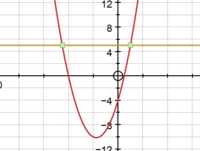Question under differentiation chapter
- Thread starter QueekJJ
- Start date
D
Deleted member 4993
Guest
Since you are lost in the beginning - let's start with definition:View attachment 25713
I had this question and got lost on where i should start. Also please do not give me answers straight away, just give me like ideas on what steps i should do so i can learn
What is the definition (mathematical) of the gradient of the curve?
pka
Elite Member
- Joined
- Jan 29, 2005
- Messages
- 11,989
Here is a start: x2+7x−9)=(2x+9)(x−1).View attachment 25713I had this question and got lost on where i should start. Also please do not give me answers straight away, just give me like ideas on what steps i should do so i can learn
HallsofIvy
Elite Member
- Joined
- Jan 27, 2012
- Messages
- 7,763
-"The curve y=2x2+7x−4 and the line y= 5 meet at the points P and Q."
The first thing you need to do is find the points P and Q: solve 2x2+7x−4=5.
That is the same as 2x2+7x−9=0 and, as pka points out, 2x2+7X−9=(2x+9)(x−1). Once you know P and Q, evaluate the derivative of 2x2+7x−9=0 at those points.
The first thing you need to do is find the points P and Q: solve 2x2+7x−4=5.
That is the same as 2x2+7x−9=0 and, as pka points out, 2x2+7X−9=(2x+9)(x−1). Once you know P and Q, evaluate the derivative of 2x2+7x−9=0 at those points.
Ah sorry for the late reply, wasn't able to use my gadget the pass few days... Thanks apple2357 and Hallsoflvy for the help, i now finally understood the question and the steps to answer it.
Just to confirm it, the answer gotten is 11 and -11. Am I correct?
Just to confirm it, the answer gotten is 11 and -11. Am I correct?
D
Deleted member 4993
Guest
Answer for what?Ah sorry for the late reply, wasn't able to use my gadget the pass few days... Thanks apple2357 and Hallsoflvy for the help, i now finally understood the question and the steps to answer it.
Just to confirm it, the answer gotten is 11 and -11. Am I correct?
You were asked to calculate gradient !
Please share your work.
Ah sorry for the late reply, wasn't able to use my gadget the pass few days... Thanks apple2357 and Hallsoflvy for the help, i now finally understood the question and the steps to answer it.
Just to confirm it, the answer gotten is 11 and -11. Am I correct?
I can confirm the gradient at the two points of intersection are 11 and -11.
Can you see how the graph suggests a symmetry?
Your answer is correct, and I suspect your reasoning was correct, but your presentation is hard to follow and outright wrong in one respect.
[MATH]\dfrac{dy}{dx} \text { is NOT equal to } 2x^2 + 7x - 4 \text { because } y = 2x^2 + 7x - 4.[/MATH]
What you could have shown is
[MATH]f(x) = y = 2x^2 + 7x - 4.[/MATH]
[MATH]y = 5 \implies 2x^2 + 7x - 4 = 5 \implies x = \dfrac{- 7 \pm \sqrt{49 - 4(2)(-9)}}{2 * 2} = \dfrac{-7 \pm {49 + 72}}{4} = 1 \text { or } - 4.5.[/MATH]
[MATH]\dfrac{dy}{dx} = 4x + 7 = f’(x).[/MATH]
[MATH]f’(1) = 4 * 1 + 7 = 11.[/MATH]
[MATH]f’(-4.5) = 4(-4.5) + 7 = - 18 + 7 = - 11. [/MATH]
Good work. Correct answers are a whole lot more important than presentation that is sweet and neat.
[MATH]\dfrac{dy}{dx} \text { is NOT equal to } 2x^2 + 7x - 4 \text { because } y = 2x^2 + 7x - 4.[/MATH]
What you could have shown is
[MATH]f(x) = y = 2x^2 + 7x - 4.[/MATH]
[MATH]y = 5 \implies 2x^2 + 7x - 4 = 5 \implies x = \dfrac{- 7 \pm \sqrt{49 - 4(2)(-9)}}{2 * 2} = \dfrac{-7 \pm {49 + 72}}{4} = 1 \text { or } - 4.5.[/MATH]
[MATH]\dfrac{dy}{dx} = 4x + 7 = f’(x).[/MATH]
[MATH]f’(1) = 4 * 1 + 7 = 11.[/MATH]
[MATH]f’(-4.5) = 4(-4.5) + 7 = - 18 + 7 = - 11. [/MATH]
Good work. Correct answers are a whole lot more important than presentation that is sweet and neat.
Yeh i just realized my mistake on doing my working after what JeffM said. Thanks <3You wrote that 2x^2 + 7x - 4 = 4x+ 7. Do you know what '=' means?


